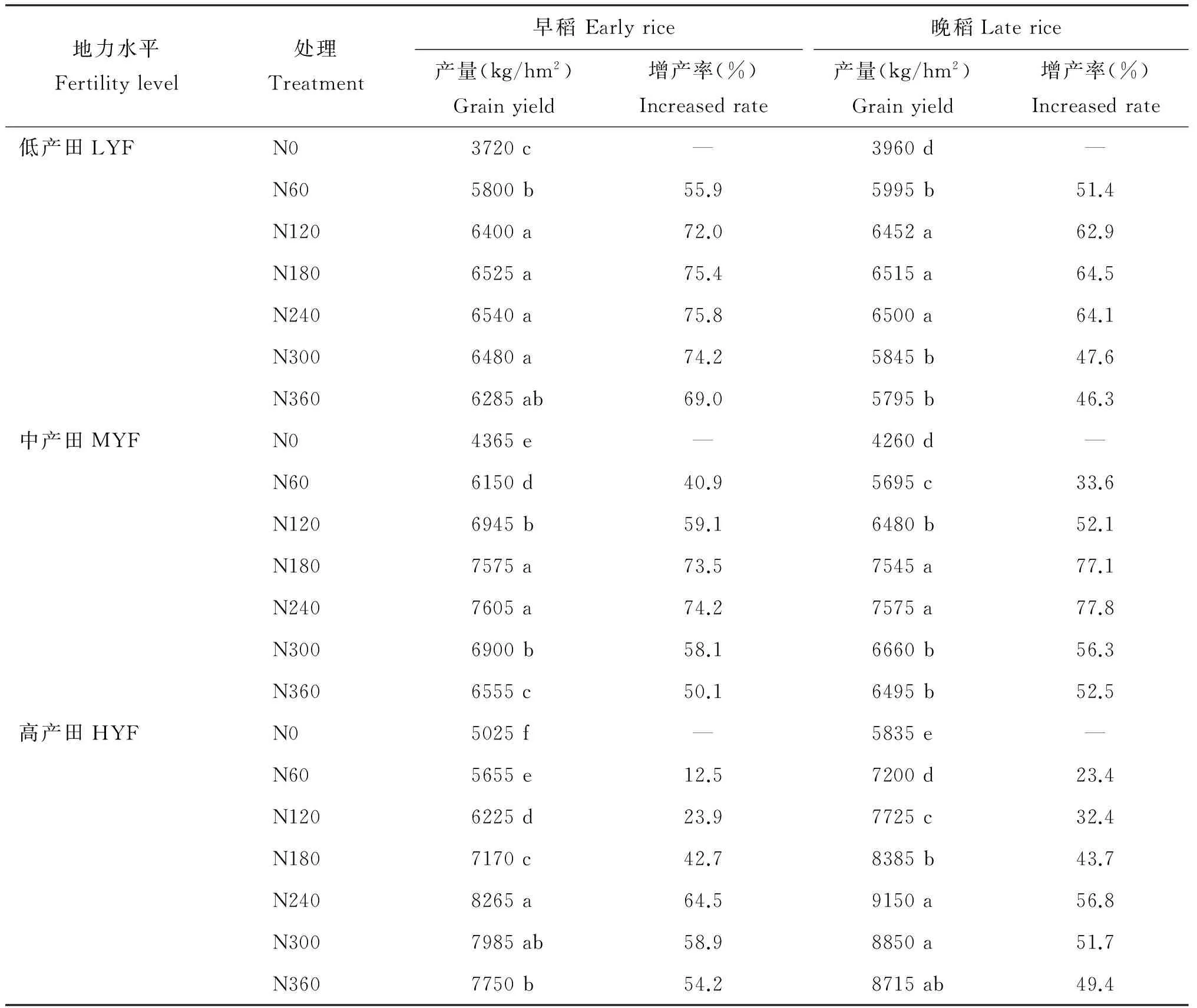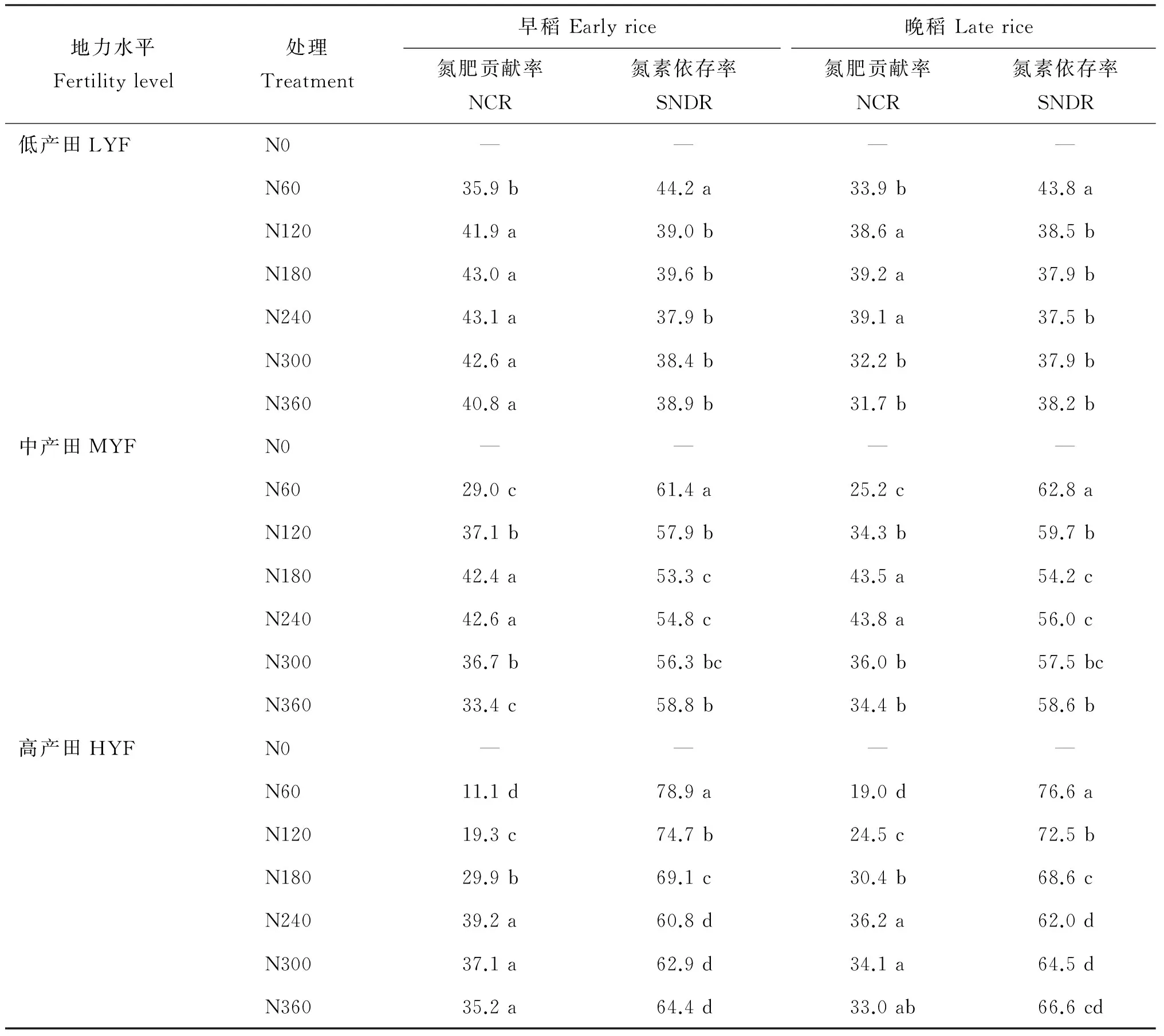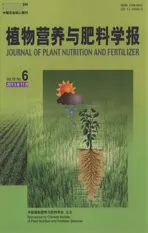氮肥用量对双季稻产量和氮肥利用率的影响
2013-10-16王秀斌徐新朋孙静文梁国庆刘光荣
王秀斌, 徐新朋, 孙 刚, 孙静文, 梁国庆, 刘光荣, 周 卫*
(1 中国农业科学院农业资源与农业区划研究所,农业部植物营养与肥料重点实验室,北京 100081; 2 江西省农业科学院土壤肥料与资源环境研究所,南昌 330200)
氮肥用量对双季稻产量和氮肥利用率的影响
王秀斌1, 徐新朋1, 孙 刚2, 孙静文1, 梁国庆1, 刘光荣2, 周 卫1*
(1 中国农业科学院农业资源与农业区划研究所,农业部植物营养与肥料重点实验室,北京 100081; 2 江西省农业科学院土壤肥料与资源环境研究所,南昌 330200)
试验采用田间小区试验,设置7个氮肥用量(N 0、 60、 120、 180、 240、 300和360 kg/hm2),研究了江西省高产田、 中产田和低产田双季稻最佳施氮量,以及不同施氮水平对水稻产量、 氮肥贡献率、 土壤氮素依存率和氮肥利用率的影响。结果表明,低产田、 中产田和高产田分别在施氮量为120、 180和240 kg/hm2处理取得高产; 氮肥贡献率在低产田和中产田上大于高产田,且分别在施氮处理为N 120、 180和240 kg/hm2达到最大;土壤氮素依存率为高产田>中产田>低产田,且在一定范围内随着施氮量的增加,土壤氮素依存率逐渐降低; 氮肥吸收利用率为低产田>中产田>高产田,氮肥农学效率、 氮肥生理利用率和氮肥偏生产力低、 中、 高产田间差异不大。高、 中、 低产田氮肥农学利用率、 氮肥吸收利用率和氮肥偏生产力随氮肥用量增加而降低,而氮肥生理利用率各施氮处理间变化不大。综合产量和氮肥利用率得出,低产田、 中产田和高产田双季稻适宜施氮量分别为N 120、 180和240 kg/hm2。
高、 中、 低产田; 双季稻; 产量; 氮肥施用量; 氮肥利用率
Abstract: Field trials with seven treatments of N application rates(N 0, 60, 120, 180, 240, 300 and 360 kg/ha) were set up to determine the optimum N application rate, and to identify the responses of N fertilization contribution rate, soil N dependent rate and N use efficiency to different N application rates in paddy fields with different yield levels(high, middle and low). The results show that the low-, middle-, and high-yield paddy fields have the highest grain yields under the application rates of N 120, 180 and 240 kg/ha, respectively. The nitrogen fertilization contribution rates(NCR) in the low- and middle- yield fields are larger than that in the high-yield field, and the highest NCRs are acquired in the treatments of N 120, 180 and 240 kg/ha for the three fields separately. Soil nitrogen dependent rates(SNPR) are in the order: high-yield field > middle-yield field > low-yield field, and the SNPR is decreased with the increase of N application rates to some extent. The trend of nitrogen recovery efficiency(NRE) is low-yield field > middle-yield field > high-yield field, whereas no distinct differences exist for nitrogen agronomic efficiency(NAE), nitrogen physiological efficiency(NPE) and nitrogen partial factor productivity(PFPN) among high-, middle-, and low-yield paddy fields. All NAE, NRE and PFPNin high-, middle-, and low-yield paddy fields are decreased with the increase of N application rates, while NPE remains relatively stable among different fertilization treatments. The optimum N application rates for double cropping rice in low-, middle- and high- yield fields are N 120, 180 and 240 kg/ha, respectively.
Keywords: High-, middle-, and low-yield paddy fields; double cropping rice; yield; nitrogen fertilizer application rate; nitrogen use efficiency

1 材料与方法
1.1 试验材料


表1 试验地块土壤理化性质
注(Note): LYF—Low yield field; MYF—Middle yield field; HYF—High yield field.
1.2 试验设计
早稻与晚稻试验设置7个施氮处理,具体为施氮(N)0、 60、 120、 180、 240、 300和360 kg/hm2,分别以N0、 N60、 N120、 N180、 N240、 N300和N360表示。小区面积20 m2,重复3次。所有小区磷肥施用量均为P2O590 kg/hm2,钾肥施用量为K2O 120 kg/hm2。磷、 钾肥均在基肥一次施入,氮肥按基 ∶蘖 ∶穗肥比例40 ∶30 ∶30施用。氮肥用尿素(含N 46.4%),磷肥用过磷酸钙(含P2O512%),钾肥用氯化钾(含K2O 60%)。试验小区田埂用塑料薄膜包裹覆盖以防止窜水窜肥,其他按当地高产方案管理。
1.3 测定项目与方法
1.3.1 氮含量测定 植株样品整株取样装网袋放入烘箱中于105℃杀青后,75℃烘干,称重,粉碎,过筛。样品经H2SO4-H2O2消煮后定容,过滤,采用流动注射分析仪测定全氮含量。
1.3.2 测产与考种 每个小区单打单收,田间直接测定产量,取1 kg水稻子粒样品,烘干后计算含水量,再通过含水量折算出实际产量。
1.3.3 计算方法
氮肥贡献率=(施氮区产量-不施氮区产量)/施氮区产量×100%
土壤氮素依存率=不施氮区地上部吸氮量/施氮区地上部吸氮量×100%
氮肥农学利用率=(施氮区产量-不施氮区产量)/施氮量
氮肥吸收利用率=(施氮区地上部吸氮量-不施氮区地上部吸氮量)/施氮量×100%
氮肥生理利用率=(施氮区产量-不施氮区产量)/(施氮区地上部吸氮量-不施氮区地上部吸氮量)
氮肥偏生产力=施氮区产量/施氮量
1.3.4 统计方法 采用Microsoft Excel 2007软件和SPSS 17.0数据处理系统进行数据统计。
2 结果与分析
2.1不同施氮量对不同产量水平稻田水稻产量的影响
表2显示,不施氮处理(N0)均是高产田产量最高,其次是中产田,低产田最低。高、 中、 低三个产量水平下稻田早稻和晚稻产量变化呈现相同的趋势,即,随着施氮量的增加,产量呈先增加后缓慢减少的趋势,施氮处理比N0的产量均有显著增加。低产田在施氮量为N 120 kg/hm2处理产量达到最大(此后施氮量增加,产量增加不显著),早稻和晚稻比N0分别增产了72.0%和62.9%;中产田在施氮量N 180 kg/hm2时产量达到最大,早稻和晚稻比N0分别增产了73.5%和77.1%;而高产田则是在施氮量为N 240 kg/hm2时产量达到最大,早稻和晚稻比N0分别增产了64.5%和56.8%。最大增产率表现为低产田和中产田大于高产田,施用氮肥对水稻产量的影响为中、低产田明显高于高产田。

表2 不同施氮量下双季稻产量及增产率
注(Note): LYF—Low yield field; MYF—Middle yield field; HYF—High yield field.同列数据后不同字母表示相同肥力水平土壤不同处理间在0.05水平差异显著 Values followed by the different letter within a column are significantly different among the treatments in the same fertility level field at the 0.05 level.
2.2不同施氮量对高、中、低产田氮肥贡献率和土壤氮素依存率的影响
由表3可以看出随着施氮量的增加,各试验田的氮肥贡献率(NCR)均呈现先升后降的趋势,且低产田和 中产田大于高产田。低产田、 中产田和高产田的NCR分别在施氮量为N 120、 180和240 kg/hm2的处理中达到最大值(此后施氮量增加, NCR增加不显著),其早稻分别为41.9%、 42.4%和39.2%, 晚稻分别为38.6%、43.5%和36.2%。

表3 不同施氮量对稻田氮肥贡献率和土壤氮素依存率的影响(%)
注(Note): LYF—Low yield field; MYF—Middle yield field; HYF—High yield field; NCR—Nitrogen fertilization contribution rate; SNDR—Soil nitrogen dependent rate. 同列数据后不同字母表示相同肥力水平土壤不同处理间在0.05水平差异显著 Values followed by the different letter within a column are significantly different among the treatments in the same fertility level field at the 0.05 level.
这一结果与获得最高产量施氮处理是一致的。而土壤氮素依存率(SNDR)各施氮水平下均表现为高产田>中产田>低产田,且随着施氮量的增加,土壤氮素依存率(SNDR)逐渐降低,当达到最高产量施氮量后不再显著下降。
2.3不同施氮量对高产田、中产田和低产田氮肥利用率的影响
表4和表5显示,无论早稻还是晚稻试验,随氮肥用量增加,高、 中、 低产田氮肥农学利用率(NAE)均呈逐渐降低的趋势,早稻最高产量施氮量下NAE分别为22.3、 17.8和13.5 kg/kg,晚稻分别为20.8、 18.3和13.8 kg/kg。
无论早稻还是晚稻试验,氮肥吸收利用率(NRE)均表现为低产田>中产田>高产田;随氮肥用量的增加,高、 中、 低产田NRE显著降低,早稻最高产量施氮量下NRE分别为44.2%、 33.2%和23.5%,晚稻分别为43.5%、 30.5%和23.8%。


表4 不同施氮量下早稻氮肥利用率
注(Note): LYF—Low yield field; MYF—Middle yield field; HYF—High yield field; NAE—Nitrogen agronomic efficiency; NRE—Nitrogen recovery efficiency; NPE—Nitrogen physiological efficiency; PFPN—Nitrogen partial factor productivity. 同列数据后不同字母表示相同肥力水平土壤不同处理间在0.05水平差异显著 Values followed by the different letter within a column are significantly different among the treatments in the same fertility level field at the 0.05 level.

表5 不同施氮量下晚稻氮肥利用率
注(Note): LYF—Low yield field; MYF—Middle yield field; HYF—High yield field; NAE—Nitrogen agronomic efficiency; NRE—Nitrogen recovery efficiency; NPE—Nitrogen physiological efficiency; PFPN—Nitrogen partial factor productivity. 同列数据后不同字母表示相同肥力水平土壤不同处理间在0.05水平差异显著 Values followed by the different letter within a column are significantly different among the treatments in the same fertility level field at the 0.05 level.

3 讨论
3.1 氮肥用量与水稻产量

3.2 氮肥用量与氮肥利用率

4 结论
1) 随着施氮量的增加,高、 中、 低产田早稻和晚稻产量均呈现先增加后减少的趋势,双季稻低、 中和高产田的适宜施氮量分别是N 120、 180 和240 kg/hm2,在此施氮量下水稻子粒产量均达到最大,此后施氮量增加,产量增加不显著或有降低;最大增产率表现为低产田、 中产田>高产田,施用氮肥对水稻产量的影响为中、 低产田明显高于高产田。
2) 随着施氮量的增加,氮肥贡献率均呈现先升高后降低的趋势,且低、 中产田大于高产田。低产田、 中产田和高产田的氮肥贡献率分别在施氮量为N 120、 180和240 kg/hm2的处理达到最大,而土壤氮素依存率则表现为高产田>中产田>低产田,且在一定范围内随着施氮量增加,土壤氮素依存率逐渐降低,当达到最高产量施氮量后不再显著减少。
3) 氮肥吸收利用率为低产田>中产田>高产田,氮肥农学利用率、 氮肥生理利用率和氮肥偏生产力同一施氮量下低、 中、 高产田间互有高低。高、 中、 低产田氮肥农学利用率、 氮肥吸收利用率和氮肥偏生产力随氮肥用量增加而降低,而氮肥生理利用率各施氮处理间变化不大;最高产量施氮量下氮肥农学利用率低、 中、 高产田早稻分别为22.3、 17.8和13.5 kg/kg,晚稻分别为20.8、 18.3和13.8 kg/kg;最高产量施氮量下氮肥吸收利用率低、 中、 高产田早稻分别为44.2%、 33.2%和23.5%,晚稻分别为43.5%、 30.5%和23.8%。
[1] FAO. Food and agriculture organization of the United Nations[DB/OL]. Statistical databases, 2004. http://faostat.fao.org.
[2] 彭少兵, 黄见良, Roland Buresh, 等. 提高中国稻田氮肥利用率的研究策略[J]. 中国农业科学, 2002, 35(9): 1095-1103. Peng S B, Huang J L, Buresh Retal. Research strategy in improving fertilizer-nitrogen use efficiency of irrigated rice in China[J]. Sci. Agric. Sin., 2002, 35(9): 1095-1103.
[3] 刘立军, 杨立年, 孙小淋, 等. 水稻实地氮肥管理的氮肥利用效率及其生理原因[J]. 作物学报, 2009, 35(9): 1672-1680. Liu L J, Yang L N, Sun X Letal. Use efficiency and its physiological mechanism under site-specific nitrogen management in rice[J]. Acta Agron. Sin., 2009, 35(9): 1672-1680
[4] 李庆逵. 中国农业持续发展中的肥料问题[M]. 江西: 江西科学技术出版社, 1997. Li Q K. Fertilizer issues in the sustainable development of China agriculture[M]. Jiangxi: Jiangxi Science and Technology Press, 1997.
[5] 朱兆良. 中国土壤氮素研究[J]. 土壤学报, 2009, 45(5): 778-783. Zhu Z L. Research on soil nitrogen in China[J]. Acta Pedol. Sin., 2009, 45(5): 778-783.
[6] Ju X T, Xing G X, Chen X Petal. Reducing environmental risk by improving N management in intensive Chinese agricultural systems[J]. Proc. Nat. Acad. Sci. USA, 2009, 106(9): 3041-3046.
[7] De Datta S K, Buresh R J. Integrated nitrogen management in irrigated rice[J]. Adv. Soil Sci., 1989, 10: 143-169.
[8] Novoa R, Loomis R S. Nitrogen and plant production[J]. Plant Soil, 1981, 58: 177-204
[9] 曾祥明, 韩宝吉, 徐芳森, 等.不同基础地力土壤优化施肥对水稻产量和氮肥利用率的影响[J].中国农业科学, 2012, 45(14): 2886-2894. Zeng X M, Han B J, Xu F Setal. Effect of optimized fertilization on grain yield of rice and nitrogen use efficiency in paddy fields with different basic soil fertilities[J]. Sci. Agric. Sin., 2012, 45(14): 2886-2894.
[10] 张福锁, 陈新平, 陈清, 等. 中国主要作物施肥指南[M]. 北京: 中国农业大学出版社, 2009. Zhang F S, Chen X P, Chen Qetal. Guide book for fertilizer recommendation of main crops in China[M]. Beijing: China Agricultural University Press, 2006.
[11] Chuan L M, He P, Jin J Yetal. Estimating nutrient uptake requirements for wheat in China[J]. Field Crops Res., 2013, 146: 96-104.
[12] Chuan L M, He P, Pampolino M Fetal. Establishing a scientific basis for fertilizer recommendations for wheat in China: Yield response and agronomic efficiency[J]. Field Crops Res., 2013, 140: 1-8.
[13] Xu X P, He P, Pampolino M Fetal. Nutrient requirements for maize in China based on QUEFTS analysis[J]. Field Crops Res., 2013, 150: 115-125.
[14] 钱永稳, 余媛, 刘燕, 等. 不同地力等级下氮肥用量对水稻产量的影响[J]. 现代农业科技, 2012, (22): 19-20. Qian Y W, Yu Y, Liu Yetal. Effect of different nitrogen applications on grain yield of rice[J]. Mod. Agric. Sci.Technol., 2012, (22): 19-20.
[15] 盛丽萍, 肖丽霞, 侯立志, 等. 靖江市水稻精确施氮技术试验研究[J]. 上海农业科技, 2011, (5): 108-110. Shen L P, Xiao L X, Hou L Zetal. Research on precise applications of nitrogen fertilizer for rice in Jingjiang[J]. Shanghai Agric. Sci. Tech., 2011, (5): 108-110.
[16] 姬景红, 李玉影, 刘双全, 等. 氮肥调控对白浆土水稻产量效益及氮肥利用效率的影响[J]. 土壤通报, 2012, 43(1): 136-140. Ji J H, Li Y Y, Liu S Qetal. Effect of different applied nitrogen methods on rice yield and nitrogen utilized efficiency in Albic soil[J]. Chin. J. Soil Sci., 2012, 43(1): 136-140.
[17] 王建明, 何晓艳, 毛华方. 太湖流域高产水稻氮磷钾肥用量的推荐[J]. 江苏农业科学, 2011, 39(2): 122-124. Wang J M, He X Y, Mao H F. Recommendation of N, P and K application for high yielding of rice in in Tai lake region[J]. Jiangsu Agric. Sci., 2011, 39(2): 122-124.
[18] 汪寿根,陈润兴. 不同氮肥用量对中嘉早17 水稻产量的影响[J]. 现代农业科技, 2011, (5): 61-63. Wang S G, Chen R X. Effect of different nitrogen application on yield of rice cultivar Zhongjiazao 17[J]. Mod. Agric. Sci. Technol., 2011, (5): 61-63.
[19] 刘立军, 桑大志, 刘翠莲, 等. 实时实地氮肥管理对水稻产量和氮素利用率的影响[J]. 中国农业科学, 2003, 36(12): 1456-1461. Liu L J, Sang D Z, Liu C Letal. Effects of real-time and site-specific nitrogen managements on rice yield and nitrogen use efficiency[J]. Sci. Agric. Sin., 2003, 36(12): 1456-1461.
[20] 张绍林, 朱兆良, 徐银华, 等. 关于太湖地区稻麦上氮肥的适宜用量[J]. 土壤, 1988, (1): 5-9. Zhang S L, Zhu Z L, Xu Y Hetal. On the optimal rate of application of nitrogen fertilizer for rice and wheat in Tai lake region[J]. Soils, 1988, (1): 5-9.
Effectsofnitrogenfertilizationongrainyieldandnitrogenuseefficiencyofdoublecroppingrice
WANG Xiu-bin1, XU Xin-peng1, SUN Gang2, SUN Jing-wen1, LIANG Guo-qing1, LIU Guang-rong2, ZHOU Wei1*
(1InstituteofAgriculturalResourceandRegionalPlanning,CAAS/KeyLabofPlantNutritionandFertilizerResearch,MOA,Beijing100081,China; 2InstituteofSoilandFertilizer&ResourcesandEnvironment,JiangxiAcademyofAgriculturalSciences,Nanchang330200,China)
2013-02-28接收日期2013-06-15
现代农业产业技术体系建设专项资金(CARS-01-31);农业部公益性行业(农业)科研专项(201003016);国家重点基础研究发展计划(2013CB127405)项目资助。
王秀斌(1975—), 男, 山西偏关人, 博士, 副研究员, 主要从事作物高效施肥方面的研究。E-mail: wangxb@caas.ac.cn * 通信作者 Tel: 010-82108671, E-mail: wzhou@caas.ac.cn
S511.062.01
A
1008-505X(2013)06-1279-08
